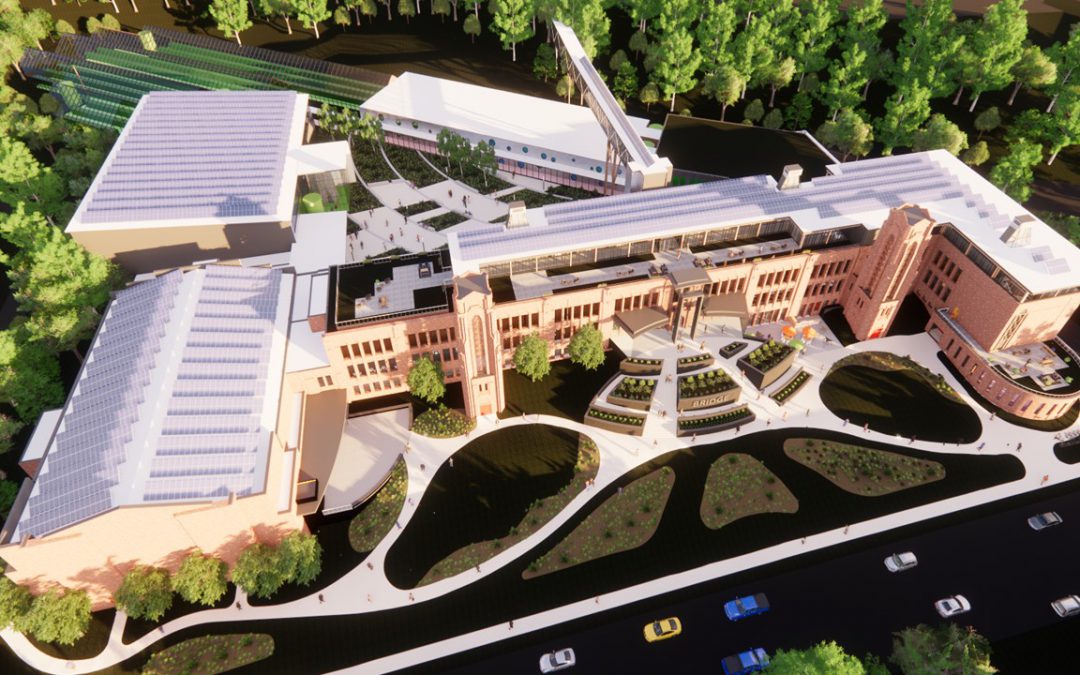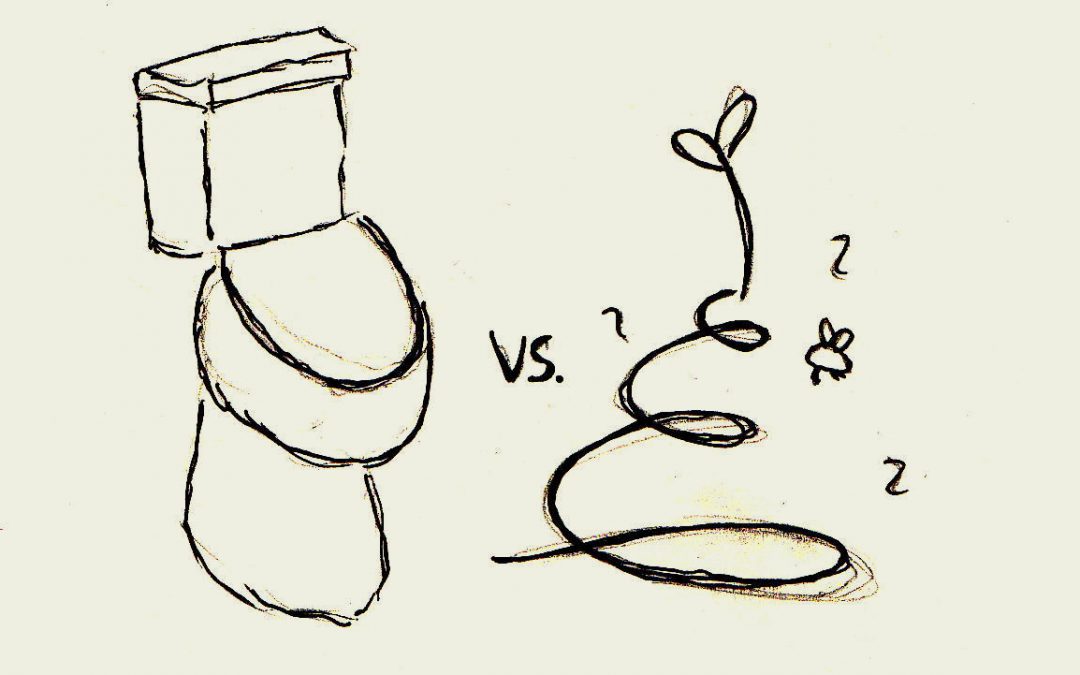
by William | Sep 16, 2020 | Healthy Living, Net Zero, Small Footprint
I think I am honestly in love. And William is right there with me. No, I am not talking about our marriage. It’s still going great, though! Thanks for asking. I am talking about our seventh Home Building Curiosity, The Bridge. The Bridge is highly unique in comparison to the curiosities who preceded it. This building curiosity is also relatively very new, and very local (well, to us at least). The Bridge is currently gathering the funds, resources, and momentum to tackle their first project: renovating the long-abandoned Bishop McDevitt Catholic school in Harrisburg, Pennsylvania into apartments, community development spaces, and educational centers. They want to turn the old school into what they are calling, an ‘eco-village.’
Much like William and I, The Bridge has five main principles that they would like to adhere to. Very unlike us, they are renovating an already standing, old, rather large, structure…a 1930’s, 115,000 square foot building resting on an eight and a half acre property, to be exact. They are also attempting to keep the building as true to its original form as possible, and only modifying the interior. We, on the other hand, are doing a small, new build.
Understandably, the five main principles are therefore different. As you may be well aware at this point, William and I’s five main principles that we want our home to follow are: meet Passive House standards, have prefabrication in mind, be net zero or even net positive, have a small footprint, and provide and enable healthy living. The Bridge’s five main principles are: Work- provide a place on-site (a makerspace, an office…) where entrepreneurs can gather together to share resources, ideas, and create, Eat- closed loop agriculture will be practiced, allowing fresh food to be available to inhabitants year round, Live- apartments will be available for rent, including affordable housing options, Learn- job training, personal development, and tutoring will be made available to inhabitants on-site, Play- arcades, concert venues, gyms, will all be on-site for inhabitants. Because this is a Home Building Curiosity, we believe that it is relevant to present The Bridge according to our five main principles. However, their five main principles will not be neglected, as you can see in the contexts of ‘net zero,’ ‘small footprint,’ and ‘healthy living.’

by William | Sep 9, 2020 | Healthy Living, Net Zero, Passive House, Prefabrication, Small Footprint
I swear, Onion Flats does it all. They do architecture. They do development. They do construction. They even do green roofs totally decked out with solar panels. They do all of this with sustainability in mind. They are utterly revamping Philadelphia, Pennsylvania to be a hub for Passive House and Net Zero readiness. Their primary goal is to reduce the operational carbon footprint of their buildings, while also admitting that embodied carbon in buildings will need to be considered if we really want to reach a sense of stable sustainability. And not only do they have a heart for green building and design…but they also have a heart to share it with our low-income, swept-under-the-carpet communities. They are physically building a world where sustainability should not just be “for the rich.”
Their completed project, Belfield, is the primary example I, personally, really want to look at. They have other incredible projects in Philadelphia which I strongly encourage you to take the independent, personal initiative to check out! But since I’m the one writing this blog, I am writing about Belfield.
The Belfield Townhomes development was Onion Flats’ first in just about everything. It was their first build from the ground-up, their first certified Passive House (PHI), and it was their first experimental prefab project. Firsts are scary. And they are even scarier when you have a time crunch. In order to qualify for federal funding, they had to design and build the modular Passive House townhomes in five months. Five months.
But the initiative was there. The townhomes were intended for “formerly homeless and low-income families” supported by the Philly non-profit, Raise of Hope. Environmentally friendly, affordable, healthy homes for the homeless…Onion Flats was all in.

by William | Jul 1, 2020 | Healthy Living, Net Zero, Passive House, Prefabrication, Small Footprint, Uncategorized
Dear Readers,
Welcome to our third Home Building Curiosity, Ecocor! As with the first two Home Building Curiosities, Ecocor is not only a curiosity, but an inspiration in the field of sustainable building. Ecocor is exceptional in how it actually meets all five of William and I’s foundational principles in our mission. Based in Searsmont, Maine, Ecocor designs and manufactures prefabricated, Passive House (PHI) certified, net zero ready, small footprint, healthy living building components and homes.
Prefabricated
Ecocor is very proud of their wall panels, and they rightly should be! Their walls are prefabricated at their Searsmont location, allowing for a climate-controlled build of each panel. Every wall panel meets Passive House standards, and has a specific assembly structure that is even being patented.
The manufacturing of individual wall panels allows Ecocor, the architect, and the buyer to get creative, while still achieving a quickly and quality built home. They promote the motto of “If it can be drawn, we can build it.” Think of their walls as super insulated, airtight, lego blocks, that allow you to build your own unique passive home.
While their wall panels are prefabricated and allow custom builds, Ecocor does have a sector devoted to prefabricated, Passive House certified, modular homes. This branch is called Solsken, which means “sunshine” in Swedish. All of the homes in their Solsken Ecocor collection are named after flowers, which William and I love (because we were actually thinking of naming our potential pipe-dream homes after trees)!

by William | Jun 24, 2020 | Net Zero, Small Footprint
Dear Readers,
If you have read the “Our Waste Goes Where?” blog (and if you have, I applaud you..that was a rough one..) or are familiar with how wastewater treatment generally works, whether it be a septic tank or a treatment facility, you may be wondering how the Clivus Multrum composting toilet and greywater system is beneficially different. I know that I was certainly curious…I mean, the results are similar. Most of the solid and liquid waste, whether flushed or composted in a hole, eventually find their way back into the great world as either fertilizer or drainage. So, what makes the idea of not just specifically the Clivus Multrum system, but a composting toilet in general, so enticing?
Since William and I are looking to build The Seed in a rural area, I am going to directly compare a composting toilet and greywater system to what is most often offered to fellow rural inhabitants…a septic tank.
Composting Toilet
A composting toilet is, for us, preferable to a septic tank for three main reasons.
1) It makes the home, and encourages the inhabitants within it to be, holistically self-sustaining, or, our version of net-zero living. Utilizing a composting toilet allows the home to have a reduced reliance and impact on the physical site it is on.
There is no digging a sand mound, or installing deep in the earth a septic tank. The solid waste that settles in the tank does not need to be pumped out by a big truck, and then subsequently dropped off at a public wastewater treatment facility.
Rather, the solid and liquid waste that the inhabitants generate rest in separate bins until they can be returned to the earth as stable soil fertilizer. The owner or resident (William and I!) can do this themselves with a simple and common tool…a shovel.
A composting toilet also results in a reduction of the home’s overall water usage. If you opt for the standard composting toilet, then you use no water when contributing your waste to compost. None. Even if you choose the foam flush composting toilet, you only use 6 ounces of water per flush. If you are relying on a rainwater pillow for your water supply, this is a HUGE plus…as well as a beautiful help in achieving net-zero living.
The greywater garden for the greywater filtration and distribution would be the only alteration required to the land…and that is because we would physically be planting a garden which would aid in filtration and dispersal. Yay, plants!
Not only would a composting system aid the home in being holistically net-zero, but it would better enable the inhabitants to take account for their own waste. Before researching for the blog, “Our Waste Goes Where??”, I honestly had no idea what happened to my processed nutrients. I figured it went to our septic tank, which I knew had to be pumped once every couple years…but I had no idea that it eventually went to a wastewater treatment facility, and what that process looked like. Someone else took care of it. All I had to do was sit on the toilet, do my thing, and flush. Done. The mess was no longer mine. Because William and I intend to raise children in this crazy idealistic home of ours, we see the composting toilet as a great life lesson for them…in William’s (and a lil’ of Shelby’s words), it will be “teaching our children to not expect other people to clean up their nasty sh…enanigans.”

by William | Jun 17, 2020 | Net Zero, Small Footprint, Uncategorized
Dear Readers,
The Clivus Multrum composting toilet is kinda cool in that its name gives the bases of how it works in two words. ‘Clivus’ is Latin for ‘incline,’ and ‘multrum’ is Swedish for ‘compost room.’ And, in essence, the Clivus Multrum composting toilet is a toilet (basically a hole) that lets waste fall into an inclined composting room. Bam. Boom. Blog is basically done.
Ha! Kidding. To give justice to the simplistic yet holistically functional toilet system, it deserves a slightly more in-depth explanation. I promise, this will be simpler than the blog about wastewater treatment facilities…
Their toilets are much more sophisticated looking than a dark, deep hole you squat or stand over. They actually look like a real toilet! Some even use a small amount of foamy, soapy water (no more than 6 ounces) to clean the bowl when you use the flush mechanism…it’s like you would never know that you just sat on top of, and contributed to, compost.
When you donate your waste as tribute to earth fertilizer, it falls down into that inclined chamber. This incline is super important: it is what keeps the urine and the poop from being one, large, smelly, conglomeration. Gravity forces the urine to filtrate downward through the solid wastes, allowing the solid waste to remain dry (and unsmelly). However, when the urine gets to the bottom of the chamber…it is no longer urine…like a butterfly, the caterpillar has gone through metamorphosis!
Wanna know the secret to changing your urine to something else (maybe not necessarily as pretty as a butterfly…)? I sure did…





